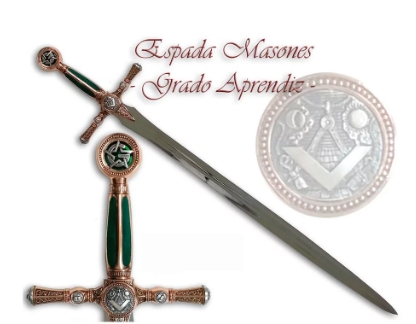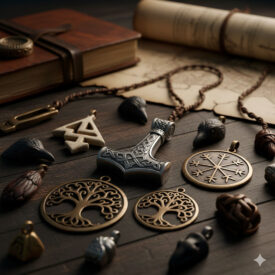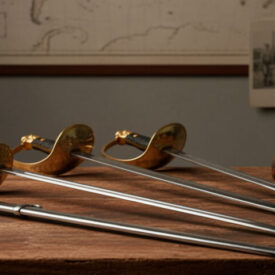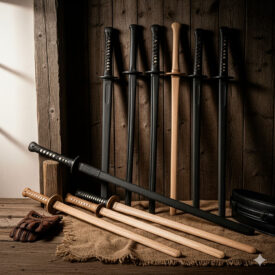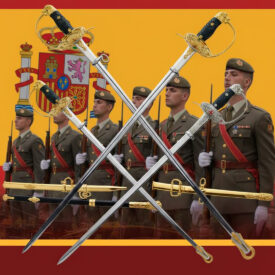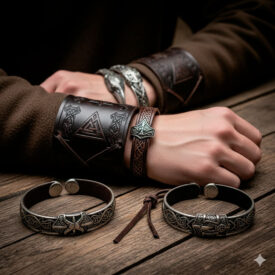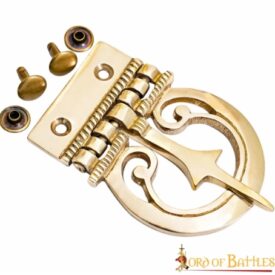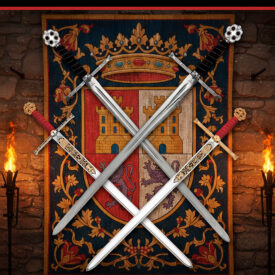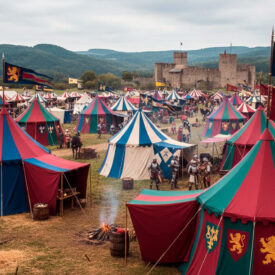Masonic swords and masons’ swords are more than ceremonial objects: they are living symbols of truth, discipline and responsibility within Freemasonry. Why did a metal blade become a central emblem of a philosophical tradition? In this article you will discover their history, their symbolism, their types, ritual uses and practical recommendations for collectors and practitioners.
Brief introduction to Freemasonry: Freemasonry is an initiatory, philanthropic and philosophical organization that promotes the search for truth and the intellectual and moral development of the human being. Its members are organized in lodges, which in turn depend on Grand Lodges or other higher bodies. In that symbolic framework, the sword takes on a different meaning than in profane contexts: it is not an instrument of war, but a tool of ethical and spiritual representation.
Masons, both men and women, use symbols — the square and compasses among them — to express ideals. The sword complements this symbolic language; it reminds the mason of his inner struggle against ignorance and the passions.
The square and compasses is the quintessential Masonic emblem
The Enigmatic Masonic Swords: symbols of truth and wisdom
What is Freemasonry and what is its connection to swords?
Modern Freemasonry consolidated in Europe during the 18th century and is based on fraternity, tolerance and moral progress. Within its rituals, masonic swords are used as symbols of protection, authority and discernment. Unlike the violent connotation that often accompanies weapons in the profane world, in the Lodge the sword is a reminder of self-control, service and duty.
The deep symbolism of the Masonic sword
In general terms, a Masonic sword can represent:
- Defense of truth and justice: the struggle against ignorance and intolerance.
- Discipline and self-control: mastery of the passions.
- Discernment: separation between right and wrong.
- Courage and progress: impetus toward freedom and personal improvement.
- Intellectual authority: the power of reason and wisdom.
- Symbolic protection: defense of the Lodge and its members against the profane.
- Solidarity and commitment: a reminder of fraternity.
MASONIC SWORDS: description and symbols on the blade
Many masons’ swords bear engravings of the compasses, the square, the plumb line, the hammer, the book, the Eye of the Divinity and the five-pointed star alongside the letter “G”. These motifs underline the connection between the ceremonial tool and Masonic principles.
The symbols of Freemasonry appear, highlighting the compasses and square, the plumb line and hammer, the book and the Eye of God, and the five-pointed star linked to the initial G of Great
For the mason, the sword is a sign of the metaphoric battle he undertakes: it is both an end and an instrument to neutralize passions, help others and advance toward the Light of the East.
Key elements in the design
- Square: integrity, honor and truthfulness.
- Compasses: spiritual life and self-control.
- Letter “G”: geometry, science and the divine presence at the center of everything.
- Hilt and guard: often richly decorated with engravings that reinforce the symbolism.
History and evolution
Although the sword is a historical weapon, the Masonic sword evolved as a ceremonial piece from the 18th century. It was never intended for battle: its function has always been symbolic and protective within the Lodge. In certain periods it also served as a visible means of social distinction and responsibility.
Types of swords in Freemasonry
1. Ordinary sword (straight)
Represents honor, valor and dignity. Parts and meaning:
- Hilt: usually metallic; motifs such as cords or skulls symbolize firmness and a warning against betraying oaths.
- Crossguard: decorated with symbolic elements pointing to strength, stability and the pillars of the Lodge.
- Blade: double-edged: one side of rights and the other of duties; the scabbard symbolizes discretion if present.
2. Flame or flame-edged sword
Insignia of the Worshipful Master in many continental rites. It is distinguished by its wavy (flame-edged) blade that symbolizes the fire of knowledge.
- Represents: spiritual power, dissemination of wisdom, active thought.
- Ceremonial use: marks the authority of the Worshipful Master and the initiate’s rebirth.
- Particularity: it is generally never sheathed, symbolizing that virtue and science should remain uncovered.
Both swords are used in different offices and rites; their presence and the way they are carried communicate precise messages to the initiates.
Practical comparison table
| Characteristic | Ordinary sword | Flame-edged sword |
|---|---|---|
| Main symbol | Honor and duty | Spiritual power and science |
| Blade | Straight, double-edged | Wavy (flame-edged) |
| Scabbard | May have a scabbard (discretion) | Usually without scabbard |
| Use | Officers and symbolic protection | Symbol of the Worshipful Master, initiations |
Swords in Masonic rituals
Their use varies according to rite and lodge, but among the most common applications are:
- Initiation and transition ceremonies: they symbolize the candidate’s inner passage.
- Representation of authority and discipline in the Lodge.
- Consecration and protection of Masonic work.
- Arch of steel or other acts of collective homage where swords are raised as a sign of respect.
Comparison of advantages and disadvantages
- Advantages: Reinforce identity and solemnity; serve as a symbolic pedagogical tool; ritually protect the Lodge.
- Disadvantages: External misinterpretations; maintenance and conservation; in some countries legal regulations on bladed weapons.
Ideal use scenarios
- Initiation rites where the symbolism must be clear and tangible.
- Controlled public acts that require representation of authority and tradition.
- Museum or historical study collections, always with contextual documentation.
Practical recommendations
- For masons: use swords in accordance with the rules of your rite and lodge; maintain ritual discretion and respect handling rules.
- For collectors: verify provenance, condition and authenticity; opt for replicas if the intention is to exhibit without legal risk.
- Maintenance: periodic cleaning with appropriate products, storage in dry, controlled environments to avoid corrosion.
- Legal matters: consult local regulations on possession and transport of ceremonial bladed weapons.
Masonic swords invite reflection: they are not mere ornaments but active reminders of ethical commitment and the search for truth. Studying them helps to better understand how materiality is integrated into the initiatory transmission of knowledge and virtues.
Interested in learning more or acquiring a ceremonial piece that respects the tradition? Explore safe, documented options; the symbolic value lies in correct use and respect for its meaning.






